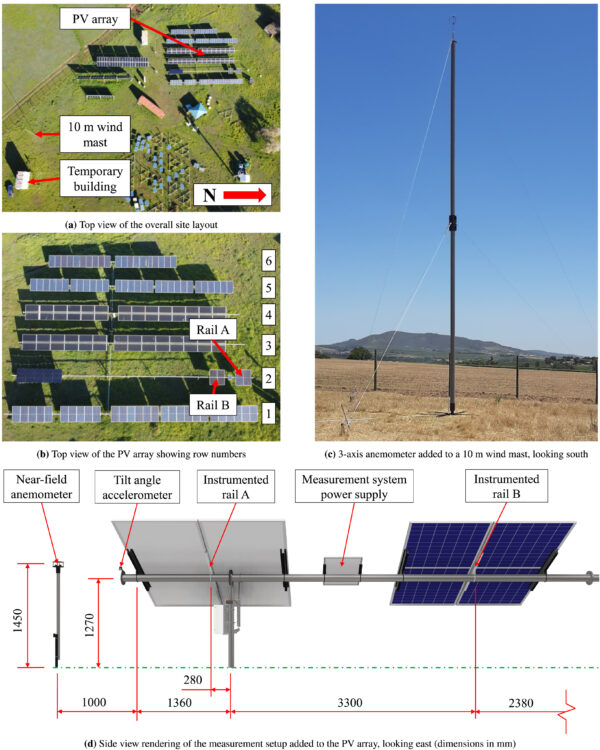A group of researchers from South Africa has conducted a full-scale field measurement of the wind load effects on the mounting rail of a PV single-axis tracker. The data was collected over 109 days in the South African province of Western Cape over two instrumented PV module mounting rails. Actual results were also compared to ASCE 7-22 estimations, the American Society of Civil Engineers' standard for design loads.
“Full-scale experiments such as these are important to provide a reference or targets for future research using wind tunnel modeling or simulation,” corresponding author, Johannes Hendrik Koekemoer, told pv magazine.
“The current investigation considers wind load effects in an omega-type cold-formed steel mounting rail. The rail is connected to the torque tube at mid-span and bolted to the PV modules at each end using a total of four anchor bolts,” said the academics. “The inherent large surfaces and lightweight support structures mean that wind loading considerations govern the structural design of large PV installations. This is exacerbated by the fact that PV installations are typically located in flat exposed locations associated with higher wind loads.”
The measurement occurred between December 2022 and March 2023 in a site dedicated to a variety of PV-related experiments that has a wind exposure category C per the ASCE 7-22. This field consisted of six PV rows, approximately 32 m long and spaced 5 m apart, using a 101 mm by 3 mm circular hollow section torque tube connected to a central swing-arm drive system. Torque tubes were mounted on polymer bearings connected to 76 mm by 4 mm circular hollow section piles.
While five of the rows participated in different research, the measurements mentioned were taken in one row. It consisted of two instrumented rails with two PV arrays installed in various positions. The PV on rail A had a length of 2.108 m, width of 1.048 m, and a mass of 24.3 kg and was positioned at the exposed outer edge of the array; while rail B had a length of 2.037 m, width of 1.005 m and a mass of 25 kg, and was located inwards from the edge of the array. Both had tilt angles of −55∘ to +55∘.

Image:
Stellenbosch University, Journal of Wind Engineering & Industrial Aerodynamics, CC BY 4.0
“The frequency content of measured loads showed contribution of the fundamental torsional mode at 3.5 Hz (𝜁1 = 0.5%) and the secondary bending mode at 4.7 Hz (𝜁2 = 0.2%) to the measured response of Rails A and B,” the research group stated. “While the torsional response was similar between both rails, Rail B showed a significantly higher bending mode response compared to Rail A. This was likely due to the position of Rail B on the torque tube, where the bending mode can more easily be excited.”
The scientists also found maximum loads occurred for an easterly wind direction when the measured row was more exposed compared to a westerly wind direction. The measurements also showed that the dominant wind direction was south and that this direction is favorable as it is not perpendicular to the rotation axis. “However, high wind speed events may still occur in more critical non-dominant wind directions, as seen for the maximum measured wind speed in this study,” they added.
The experimental results were compared to coefficients for fixed-tilt systems from ASCE 7-22. “For normal forces, the peak static coefficients for Rails A and B ranged between 2.0 and 2.1, which is lower than the code values ranging between 2.4 and 4.6. The corresponding dynamic coefficient ranged between 0.7 and 1.0, which is within the code's range of 0.4 to 1.5,” the researchers explained. “The experimental static moment coefficients ranged between 0.36 and 0.40, and compare favorably to code values ranging between 0.29 and 0.64. The dynamic part indicated values of between 0.22 and 0.23 for the experiment, compared to code values ranging from 0.29 to 0.64.”
Their findings were presented in “Field measurements of wind load effects in a photovoltaic single-axis tracker mounting rail,” published in the Journal of Wind Engineering & Industrial Aerodynamics. Academics from Stellenbosch University and the South African chapter of renewable energy systems company Scatec conducted the research.
This content is protected by copyright and may not be reused. If you want to cooperate with us and would like to reuse some of our content, please contact: editors@pv-magazine.com.



By submitting this form you agree to pv magazine using your data for the purposes of publishing your comment.
Your personal data will only be disclosed or otherwise transmitted to third parties for the purposes of spam filtering or if this is necessary for technical maintenance of the website. Any other transfer to third parties will not take place unless this is justified on the basis of applicable data protection regulations or if pv magazine is legally obliged to do so.
You may revoke this consent at any time with effect for the future, in which case your personal data will be deleted immediately. Otherwise, your data will be deleted if pv magazine has processed your request or the purpose of data storage is fulfilled.
Further information on data privacy can be found in our Data Protection Policy.